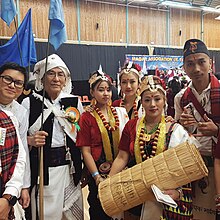
Back الماغار Arabic Магары BE Magar Catalan Magarové Czech Magar (Ethnie) German Pueblo magar Spanish मगर जाति HI Magar Italian マガール Japanese Магарлар KK
 Magars in traditional dress | |
| Total population | |
|---|---|
| 2,309,498 | |
| Regions with significant populations | |
| 2,013,498 (6.9% of Nepal's population) (2021)[1] | |
| 278,000 (2006)[2] | |
| Languages | |
| Native: Magar Dialect: Magar Kham, Magar Kaike, Magar ḍhuṭ Also: Nepali[3] | |
| Religion | |
| Hinduism 79.4%, Buddhism 18%, Christianity 2.2%, Prakriti 0.4% [4] | |
| Related ethnic groups | |
| Gurung, Tamang, Tibetan, Thakali and Sherpa | |
The Magars, also spelled Mangar and Mongar, are a Tibeto-Burman ethnic group native to Nepal and Northeast India, representing 6.9% of Nepal's total population according to the 2021 Nepal census.[5] They are one of the main Gurkha tribes.

The first home of the Magars was to the west of the Gandaki River and, roughly speaking, consisted of that portion of Nepal which lies between and around about Gulmi, Arghakhanchi, and Palpa.[6] This part of the country was divided into twelve districts known as Bahra Magarat (Confederation of Twelve Magar villages), which included the following regions of that period: Argha, Khanchi, Bhirkot, Dhor, Garhung, Ghiring, Gulmi, Isma, Musikot, Rising, Satung, and Pyung.[6] During the medieval period, the whole area from Palpa to Rukum Rolpa was called the Magarat, a place settled and inhabited by Magars.[7] Another confederation of eighteen Magar kingdoms, known as Athara Magarat, also existed and was originally inhabited by Kham Magars.
- ^ National Statistics Office (2021). National Population and Housing Census 2021, Caste/Ethnicity Report. Government of Nepal (Report).
- ^ "Magar, Eastern". Ethnologue. Ethnologue. Retrieved 28 September 2023.
- ^ "The Eastern Magar of Nepal". Archived from the original on 2007-03-18. Retrieved 2007-09-12. Note: In Nepal 788,530 are Magar speakers.
- ^ "go to page 55 for detail data of Hinduism among various ethnicities in Nepal" (PDF).
- ^ National Statistics Office (2021). National Population and Housing Census 2021, Caste/Ethnicity Report. Government of Nepal (Report).
- ^ a b Cite error: The named reference
:2was invoked but never defined (see the help page). - ^ Vaidya, Tulasī Rāma; Mānandhara, Triratna; Joshi, Shankar Lal (1993). Social history of Nepal. Anmol Publications. ISBN 978-8170417996.